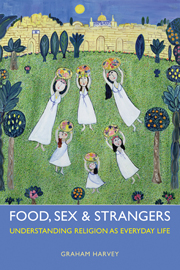Book contents
- Frontmatter
- Dedication
- Contents
- Preface
- 1 Of god and goats
- 2 Religioning elsewhere
- 3 Christianity is not a religion
- 4 Talking like a pirate
- 5 Real world
- 6 Doing violence with impunity
- 7 Respecting relations
- 8 Things full of meaning
- 9 Purity and pilgrimages
- 10 Enchantment and emplacement
- 11 Christians do religion like other people
- 12 Religion is etiquette in the real world
- Bubliography
- Index
12 - Religion is etiquette in the real world
- Frontmatter
- Dedication
- Contents
- Preface
- 1 Of god and goats
- 2 Religioning elsewhere
- 3 Christianity is not a religion
- 4 Talking like a pirate
- 5 Real world
- 6 Doing violence with impunity
- 7 Respecting relations
- 8 Things full of meaning
- 9 Purity and pilgrimages
- 10 Enchantment and emplacement
- 11 Christians do religion like other people
- 12 Religion is etiquette in the real world
- Bubliography
- Index
Summary
Religion evolved in a relational and material world. The recent human experiment of hyperseparation may have misled interpreters of religion, but it has not entirely rerouted the trajectory of religioning. Not only within the many ways of resisting modernism, but also within the many ways of being modern, religions are perhaps most easily observed (seen, heard, smelled, tasted and touched) when people ritualize together. The bits of religion where people teach others are required because people need to be formed and reformed to relate in ways that are deemed locally appropriate. In such ways, persons are made, and so are communities. But these rituals and teaching practices should not be treated in isolation from everyday life. Just as life cannot be divided between secular and spiritual phases, religion is diffused throughout everything people do. It is integral to everyday human encounters in a multi-species material, relational world.
RESEARCHING DELUSIONS
Understanding religion has been made difficult by our entanglement in confusions about what kind of modernity we inhabit. In truth, there has never been a pure modernity, so we have never been completely modern. We have, however, been trying rather hard. Similarly, we have never really been completely disenchanted, but we have succumbed to a particular kind of rationalism. We have imagined ourselves divorced from bodies, communities and places.
- Type
- Chapter
- Information
- Food, Sex and StrangersUnderstanding Religion as Everyday Life, pp. 199 - 220Publisher: Acumen PublishingPrint publication year: 2013



